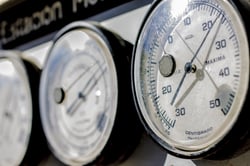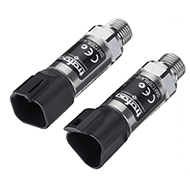Harsh environments can be considered harsh in a variety of ways, but extreme temperatures and pressures are often two of the most pressing concerns for design engineers dealing with extreme conditions. Temperature can have a significant impact on both the function and operating lifetime of pressure sensors, which can pose significant challenges when pressure sensors are required in harsh environmental conditions.
Pressure Sensing at Extreme Temperatures
Pressure sensing applications are no stranger to harsh conditions that often involve extreme temperatures. For some applications, the ambient temperature may fluctuate widely and quickly, or the pressure media may be at a high temperature.
For example, petrochemical pipeline networks need pressure to be monitored accurately and reliably to avoid failure, and these networks often cross radically different climates than can involve extreme temperatures. Other extreme temperature environments for pressure sensors include machine tools, nuclear reactors, hydraulic power units, HVAC, aerospace, shipbuilding, and railways.
Because many of these extreme temperature applications are mission critical, it is vital that suitable pressure sensors be used. And temperature is not the only issue here because unsuitable sensors can also be damaged by exposure to radiation, corrosive fluids, pressure pulsations, or pressure spikes.
Temperature Ranges for Pressure Sensors
Most pressure sensor specifications include maximum and minimum values for three different types of temperature: operating temperature, storage temperature, and media temperature. The operating (or ambient) temperature range relates to the temperature that the transmitter body is exposed to while the sensor is in operation. That means that if the transmitter housing temperature falls outside the allowable range, the output signal may experience significant drift or, even worse, the transmitter may stop operating.
As the name implies, storage temperature refers to the temperature at which the sensor can be stored when not in use. Of the three operating temperature ranges for pressure sensors, the storage temperature is usually widest. This is primarily because the circuits are less susceptible to damage related to extreme temperatures when they are not operating.
The media temperature relates to the actual process whose temperature is being measured and has the greatest impact on pressure sensor performance, including the accuracy of the readings obtained. When specifying a pressure sensor, always select one with a media temperature range greater than the expected range.
Trafag Pressure Sensors
The Trafag pressure sensor product line includes transmitters, sensors, and gauges that have an established reputation for performance in harsh conditions, including temperature extremes. Trafag pressure sensors are engineered for demanding applications that require temperature insensitivity, long-term vibration resistance, shock resistance, and electromagnetic compatibility.
Trafag Pressure Sensor Technology

Trafag uses 2 types of technology for pressure sensors: thin-film-on-steel and thick-film-on-ceramic. Thin-film-on-steel pressure sensors offer long-term stability, excellent resistance to high media temperatures, and is designed as a completely welded stainless steel sensor that does not require o-rings. Trafag’s thin-film-on-steel pressure sensors are also resistant to very high over pressures and are ideal for applications involving nominal pressures up to 3000 bar.
The Trafag thick-film-on-ceramic pressure sensors are well-adapted to use with aggressive media and are ideal for applications with low pressure ranges that require absolute pressure measurement. Both types of Trafag's pressure sensor technology results in a compact, miniaturized solution.
Trafag Pressure Switches
Trafag pressure switches also perform well in harsh conditions. Robust and durable, they can easily operate for decades without requiring maintenance. These harsh environment pressure switches offer switch point precision and excellent vibration resistance. Trafag pressure switches are available in designs that cover a range of pressure ranges, different types of media, and various load profiles, as well as membrane, bellows, and piston sensor covers.
PEI-Genesis: Your Source for Harsh Environment Pressure Sensors
Extreme temperatures can introduce error into pressure sensor readings and even result in failure of the sensor itself. If you need assistance in finding a rugged, reliable pressure sensor solution, let the experts at PEI-Genesis help. We will help you find the right combination of sensors, transmitters, and switches that take into account harsh conditions, electrical output signals, measurement procedures, and certifications (CE, EX, rail and ship).










